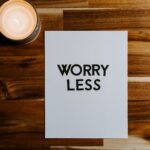May is National Meditation Month, and what better time to explore the art of meditation? It’s no secret that many people struggle with financial anxiety, and meditation is a powerful tool for managing stress related to finances by increasing focus and achieving a greater sense of peace and well-being. Let’s explore what meditation is, how it affects the brain, and how to get started with a meditation practice.
What Is Meditation and How It Affects Our Brains?
Meditation is a practice that involves training the mind to focus and quiet the constant chatter that goes on in our heads. This can be done by focusing on the breath, a sound, or a visual image. Meditation is a way to cultivate mindfulness, which is the practice of being present and fully engaged in the current moment.
Research has shown that meditation can have a number of positive effects on the brain. For example, it can increase gray matter in the prefrontal cortex, which is responsible for decision-making, attention, and impulse control. It can also reduce activity in the amygdala, which is responsible for processing emotions such as fear and anxiety. Additionally, meditation has been shown to improve memory, reduce stress, and increase feelings of well-being.
How Can You Start to Meditate?
Meditation has been around for thousands of years, and over time, different styles and techniques have emerged. While some people prefer traditional, classic meditation styles, others may find alternative styles more appealing.
The classic meditation style involves focusing the mind on a single point or object, while alternative styles allow for more freedom and creativity in the meditation process. Both can be effective in promoting relaxation, reducing stress, and improving overall well-being.
Classic Meditation Style
Starting a meditation practice can seem intimidating at first, but it doesn’t have to be. Here are some steps you can take to get started:
- Set aside time: Choose a time when you can meditate without interruptions. This could be first thing in the morning, during your lunch break, or in the evening before bed.
- Find a quiet space: Choose a quiet space where you can sit comfortably without distractions. You can use a cushion or a chair, as long as you can sit with your back straight.
- Focus on your breath: Close your eyes and focus on your breath. Take deep breaths in and out, and notice the sensation of the air moving in and out of your body.
- Let your thoughts come and go: Don’t worry if your mind starts to wander. Just notice when your thoughts start to drift, and gently bring your focus back to your breath.
- Start small: You don’t need to meditate for hours on end to experience the benefits of meditation. Start with just a few minutes a day, and gradually increase the amount of time you spend meditating.
Alternative Meditation Styles
Start Moving!
For example, walking meditation is a type of meditation where you walk slowly and mindfully while focusing on your breath and the sensation of your feet touching the ground. It can be a great way to cultivate mindfulness while also getting some gentle exercise.
There’s also yoga, which combines movement with breath and can be a great way to cultivate mindfulness while also improving flexibility, strength, and balance. There are many different styles of yoga, so you can choose one that suits your needs and preferences.
Other types of meditation that don’t involve sitting still include qigong, tai chi, and even running or swimming. The key is to find an activity that allows you to focus your attention on your breath or a specific sensation, and to approach it with a mindful attitude.
The beauty of these types of meditation is that they can be done anywhere, and don’t require any special equipment or clothing. You can do walking meditation in a park, yoga in your living room, or qigong in your backyard. By incorporating movement into your meditation practice, you can experience the benefits of mindfulness while also getting some physical activity.
Everyday Activities
While it may not seem like it, doing house chores can be a meditative activity if you approach it with the right mindset. By focusing your attention on the task at hand and being fully present in the moment, you can turn mundane chores like washing dishes or folding laundry into a mindfulness practice. Try to approach each task with a sense of curiosity and non-judgment, and use it as an opportunity to connect with your body and breath.
Writing can be a form of meditation because it allows you to get in touch with your thoughts and feelings and process them in a mindful way. Whether you’re journaling, writing a story, or composing a poem, try to approach the process with a sense of openness and non-judgment. Allow yourself to write freely and without censorship, and use the act of writing to explore your inner world and connect with your creativity.
Trying new things can be a form of meditation because it forces you to step out of your comfort zone and be fully present in the moment. Whether you’re trying a new hobby, learning a new skill, or exploring a new place, try to approach the experience with a sense of curiosity and openness. Use it as an opportunity to connect with your senses and experience the world in a new way.
In each of these cases, the key is to approach the activity with a mindful attitude and to focus your attention on the present moment. By doing so, you can turn everyday activities into a form of meditation and experience the many benefits that come with a regular meditation practice.
Bottom Line
Meditation is a powerful tool for managing stress, increasing focus, and achieving a greater sense of peace and well-being. National Meditation Month is a great time to start a meditation practice, and by following the steps outlined above, you can get started on your journey to mindfulness. Remember, it’s okay if your mind wanders during meditation – just notice when it does and gently bring your focus back to your breath. With practice, you can experience the many benefits of meditation and cultivate a greater sense of mindfulness and inner peace.
What forms of meditation have you tried in the past? Did you know about the alternative styles of meditation mentioned above? We’d love to hear from you. Please feel free to leave a comment or reach out to me via Twitter or Facebook. At LexION Capital, our priority is to make our clients’ financial goals a reality by providing hands-on wealth management solutions, backed up by science-based insights into the financial industry. We help you maintain well-diversified investment plans. Should you need help in the aspect of financial growth, please visit my company’s website, LexION Capital.
Elle Kaplan is the founder and CEO of LexION Capital, a fiduciary wealth management firm in New York City serving everyone who feels left out by traditional “Wall Street”, including women and the families they love.










